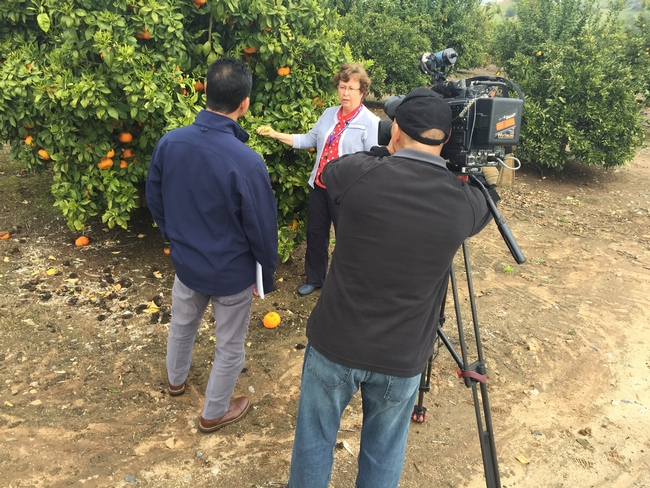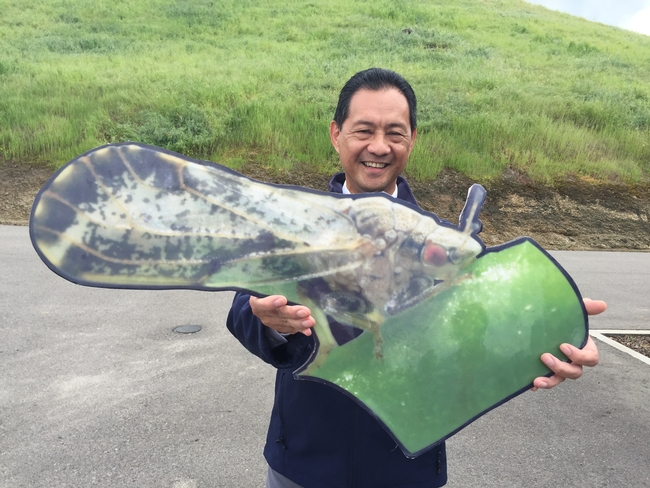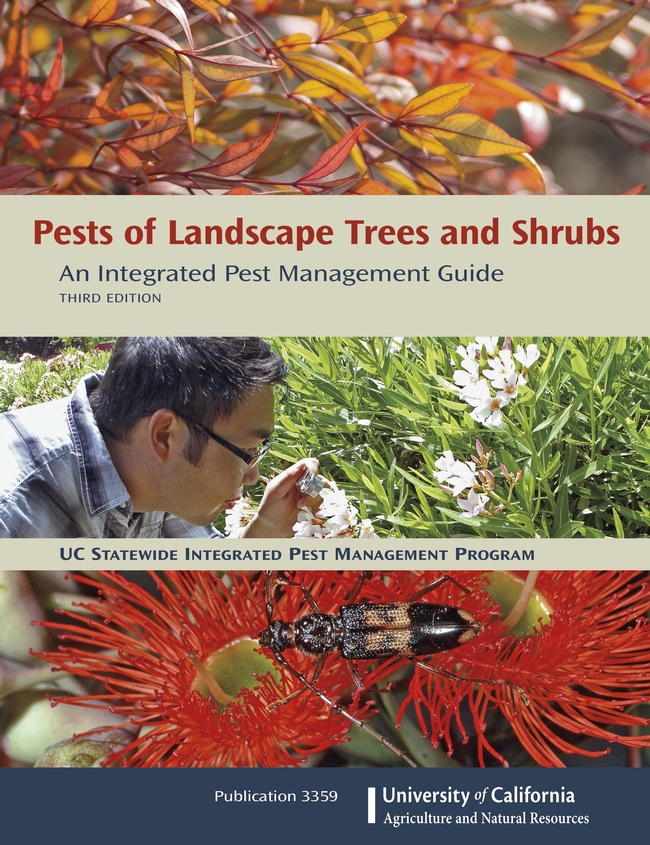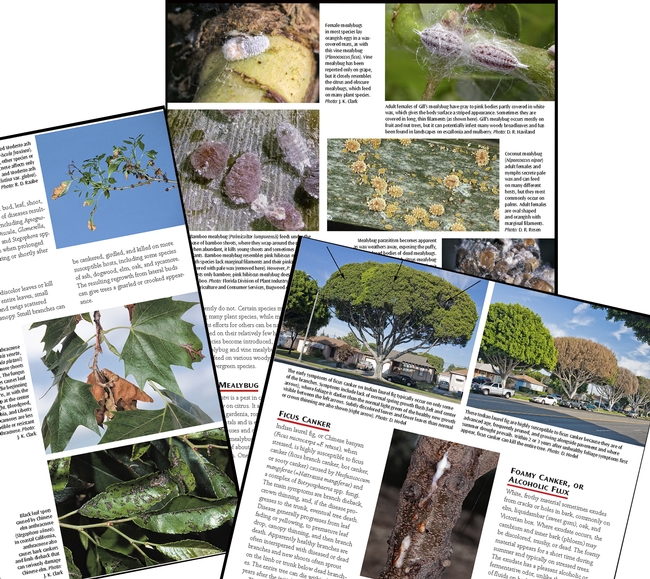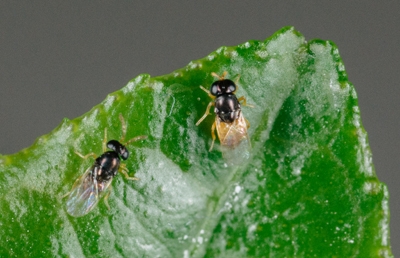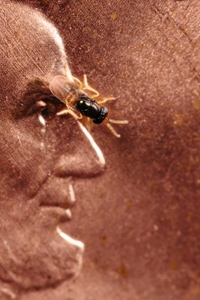Posts Tagged: citrus
Citrus trees sprayed for Asian citrus psyllid in Highland
Backyard citrus trees in Highland, Calif., were sprayed with a pesticide to kill Asian citrus psyllids, reported Jim Steinberg in the San Bernardino Sun. The invasive pests pose a threat because they can carry huanglongbing disease, which is incurable. The California Department of Food and Agriculture is treating trees that have ACP to keep the pest number in California low.
“What they are really doing is buying time until disease resistant trees become available, or there is some treatment for the (huanglongbing) disease,” said Matt Daugherty, a UC Cooperative Extension entomology specialist based at UC Riverside.
The reporter also spoke to Beth Grafton-Cardwell, who is a UCCE entomology specialist at UC Riverside and director of the UC Lindcove Research and Extension Center in Tulare County. She said that it is unlikely huanglongbing was completely wiped out in the Southern California areas where infected trees have been found, even though CDFA destroyed the infected trees.
A tree can be infected for a year before it shows symptoms, she said.
Grafton-Cardwell asks homeowners to monitor backyard trees for signs of Asian citrus psyllid and report any finds to CDFA or their county agricultural commissioner's office. For more information, see the video below.
Californians are checking new growth on citrus for Asian citrus psyllid
"Basically, you just look really closely (at new growth) with any kind of magnifying device you have to see if you can find any insects on there," Grafton-Cardwell said.
If tiny yellow eggs, sesame seed-sized nymphs, or ACP adults are found, take action. Maps, treatment protocols and other information that detail what to do when ACP is present are available at http://ucanr.edu/acp.
Since ACP can spread the devastating citrus disease huanglongbing (HLB), controlling the insect population will buy time for researchers working around the world to find a way to grow healthy and delicious citrus fruit in the presence of HLB.
Yurong reported that the disease has been found in a dozen Southern California trees. Grafton-Cardwell figures Valley trees will ultimately get infected.
"HLB is going to come. We fully expect it to come up here because it rides in the bodies of the psyllids," she said.
Reed Fujii of the Stockton Record interviewed Karey Windbiel-Rojas, a UCCE advisor for home and garden integrated pest management, for a story on Asian citrus pysllid.
“It's really important to detect Asian citrus psyllid in backyard trees because one psyllid can carry the disease from tree to tree in a residential landscape,” Windbiel-Rojas. “Citrus growers, they treat all their fields, but home gardeners don't necessarily treat or monitor their backyard trees so it can spread a lot faster in backyards than in managed citrus orchards.”
Stories about the call to check trees this spring for Asian citrus psyllid also appeared in:
- El Informador del Valle
- The Porterville Recorder
- Monterey County Herald
- Turlock Journal
- Santa Cruz Sentinel
- Morning Ag Clips
- Hoy, a Los Angeles Times Spanish language publication
- Valley Public Radio, Fresno
- AgNewsWest newsletter
- California Department of Food and Agriculture Planting Seeds Blog
- Inland News Today, Riverside
- East County Magazine, San Diego
- Highland Community News, Highland
- Central Valley Business Times, Fresno
- KXO Radio, Imperial
- AgNetWest.com, California
- UC Office of the President News Page, Oakland
View a four-minute video about Asian citrus psyllid here:
Check Your Citrus Trees for Signs of This Pest
If you're a California commercial citrus grower or a homeowner with a citrus tree on your property, be sure to check for signs of the Asian citrus...
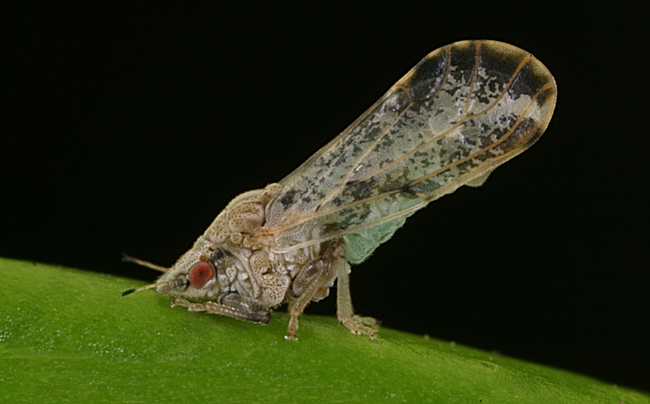
An adult Asian citrus psyllid. (Photo by M. Rogers)
What’s attacking your landscape? Read all about it in the newly released book from UC ANR
What do Asian citrus psyllids, Bagrada bugs, brown marmorated stink bugs, palm weevils, and polyphagous shothole borers have in common? Not only are they invasive pests relatively new to California, but they have also been added to the newly revised ANR publication, Pests of Landscape Trees and Shrubs.
Now in its third edition, this integrated pest management (IPM) how-to guide is a comprehensive resource for arborists, home gardeners, landscapers, parks and ground managers, and retail nurseries. It contains solutions for hundreds of insects, mites, nematodes, plant disorders and diseases, and weeds that can damage California landscapes.
Dozens of pests new to this edition include those affecting azaleas, camellias, camphor, eucalyptus, hibiscus, liquidambar, maples, oaks, olive, palms, pines, roses and sycamores.
A very important part of pest management is designing a pest-tolerant landscape, choosing the right plants for the location, and maintaining the landscape with appropriate irrigation, fertilizer, and other cultural practices to keep plants healthy.
These practices are featured along with information on how to:
- prevent pest problems and plant damage
- monitor for pests efficiently
- conserve natural enemies to provide biological control, and
- selectively use pesticides in ways that minimize adverse impacts
Presenting the practical experience and research-based advice of more than 100 University of California experts and landscape professionals, this 437-page book includes more than 600 high-quality color photographs and line drawings to help you recognize important pests and key natural enemies, causes and symptoms of plant damage, and pest biology and control techniques.
Problem-Solving Tables include the specific pests for each of over 200 genera of trees and shrubs, referring to the pages with their photographs and management solutions.
Pests of Landscape Trees and Shrubs: An Integrated Pest Management Guide, Third Edition, can be ordered through the ANR catalog. For more information, see the UC IPM website.
A second natural enemy of Asian citrus psyllid joins the battle
The battle against Asian citrus psyllid (ACP) is continuing in California on many fronts, motivated by the insect's ability to spread huanglongbing (HLB), the worst citrus disease in the world. HLB has been found in only one isolated tree in California, and everybody who enjoys California citrus wants it to stay that way.
Farmers are diligently treating orchards where the pest has been found, county ag commissioners are monitoring traps to keep tabs on ACP movement, and UC researchers are looking into a wide variety of novel techniques to disarm ACP and the disease. In December, UC Cooperative Extension biological control specialist Mark Hoddle began releasing a newly imported natural enemy of ACP, Diaphorencyrtus aligarhensis (DA).
“We've released about 2,000 now at select urban sites,” Hoddle said. “It's too early to tell if we are getting attacks, but we are monitoring carefully for this type of activity.”
Hoddle said it isn't the ideal time for DA to become established in California citrus. Cool weather and short days have hindered ACP population growth, so DA likely are struggling to find enough ACP to attack.
“But we keep pumping them out there as the alternative is letting them to die in quarantine,” Hoddle said. “At least if they are outside they may find some ACP to kill.”
Hoddle has searched the world for natural enemies of exotic pests since he joined the UC Division of Agriculture and Natural Resources in 1997. He collected DA in Pakistan three years ago, then raised and studied colonies of the sesame-seed-sized insect in quarantine at UC Riverside. The wasp joins a cousin, Tamarixia radiata, also imported from Pakistan by Hoddle, to search out and destroy Asian citrus psyllid. He began releasing Tamarixia in 2011.
Since then, CDFA has raised a million Tamarixia and released them in Southern California for ACP management. It appears Tamarixia has become established, is moving around on its own and killing Asian citrus psyllids. State and federal agencies are now beginning to work with DA as well.
“We've given starter colonies of the new insect to CDFA. They have a mass rearing facility at Mt. Rubidoux in Riverside, where they currently mass produce Tamarixia,” Hoddle said.
USDA plans to set up field cages around citrus trees in late spring or early summer and prune them severely to encourage new growth. ACP will be placed in the cages to enjoy the fresh, aromatic stems and leaves on the trees, and DA will be released in large numbers to attack the ACP.
“Infested branches will be trimmed off trees, taken to the lab where parasitoids are then harvested,” Hoddle said. “The adult ACP will be trapped inside the cages and killed.”
For more details, photos and a video about the new enemy of Asian citrus psyllid, see the Center for Invasive Species Research website.
An initiative to manage endemic and invasive pests and diseases is part of UC Agriculture and Natural Resources Strategic Vision 2025.



